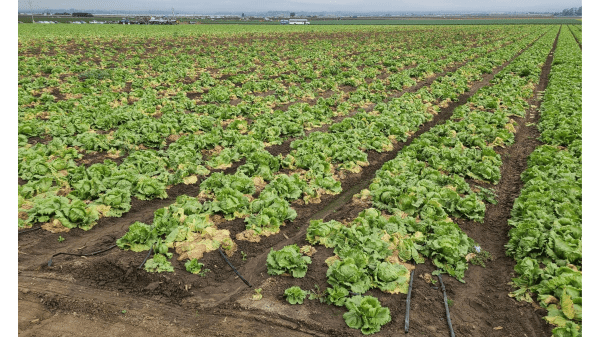No one should fault the California leafy greens industry for its disastrous season, which is coming to an end now.
But it has been a harsh one.
Mary Zischke, facilitator for the INSV and Pythium task force with the Grower Shipper Association BB #:162651 in Salinas, has estimated that 20 percent of the Salinas Valley crop has been affected by Impatiens necrotic spot virus (INSV). California lettuce quality problems worsen – Produce Blue Book Pythium wilt has been another culprit.

One grower said that he had seen 20-acre fields from which not a single head of lettuce could be harvested.
This situation is changing at present, as desert crops come in. Price relief coming soon to lettuce markets – Produce Blue Book
But the supply disruption may in the long run cause as many problems for California leafy greens as the viruses that have devastated the crop.
Sylvain Charlebois, a prominent Canadian retail grocery analyst, suggests that right now, our northern neighbor is becoming exasperated not only with shortages of lettuce, but with its total absence from some venues: “Over the last few weeks, lettuce is almost impossible to find in big box stores. But if lettuce is to be found, it is 30% to 40% overpriced, on average.” Let’s romaine calm: Lettuce shortage an opportunity for Canada to rethink trade | Canadian Grocer
Charlebois views the situation from an angle that may be unfamiliar to many American observers.
It has become routine for Southeastern U.S. growers to complain about unfair competition from Mexican crops such as tomatoes and blueberries.
But Canada could make the same complaint about lettuce.
Here too it is the result of the free-trade agreements that have been implemented by the North American nations over the last 30 years.
“Canada did farm lettuce before, and lots of it,” Charlebois writes. “The first lettuce ever to be grown in Canada was in 1927. The United States did supply us with lettuce before, but our farmers were competitive. Scale became an issue, which is why Canada started to import more product from the United States. Farming in Canada was very diverse from the 40s to the 80s, just before NAFTA 1.0 came along [in 1994]. About 40 years ago everything changed, and it made more sense to import produce at a lower price. Canada now buys well over $1 billion worth of fresh vegetables per year.”
Charlebois is not advocating trade barriers or retaliation. But he does suggest that California in the long run may cease to be a reliable supplier (because of climate change, among other issues). Consequently, he said, Canada needs to become more self-reliant in vegetable production—even in the severe Canadian winter.
In that context, it would mean controlled-environment agriculture. “Growing lettuce in a controlled environment is capital-intensive and would require optimal plant science and genetics,” he said.
Nevertheless, CEA—particularly vertical agriculture—is far more advanced for leafy greens than for many crops. Vertical Farming Needs to Grow More Than Salad | WIRED
All blame aside, if American leafy greens suppliers—not only in the Salinas Valley, but in the desert areas, which are facing an unprecedented water crisis—can’t provide their crop reliably, it’s likely to accelerate the push toward other sources, including CEA and vertical options, where leafy greens opportunities are being vigorously pursued.



